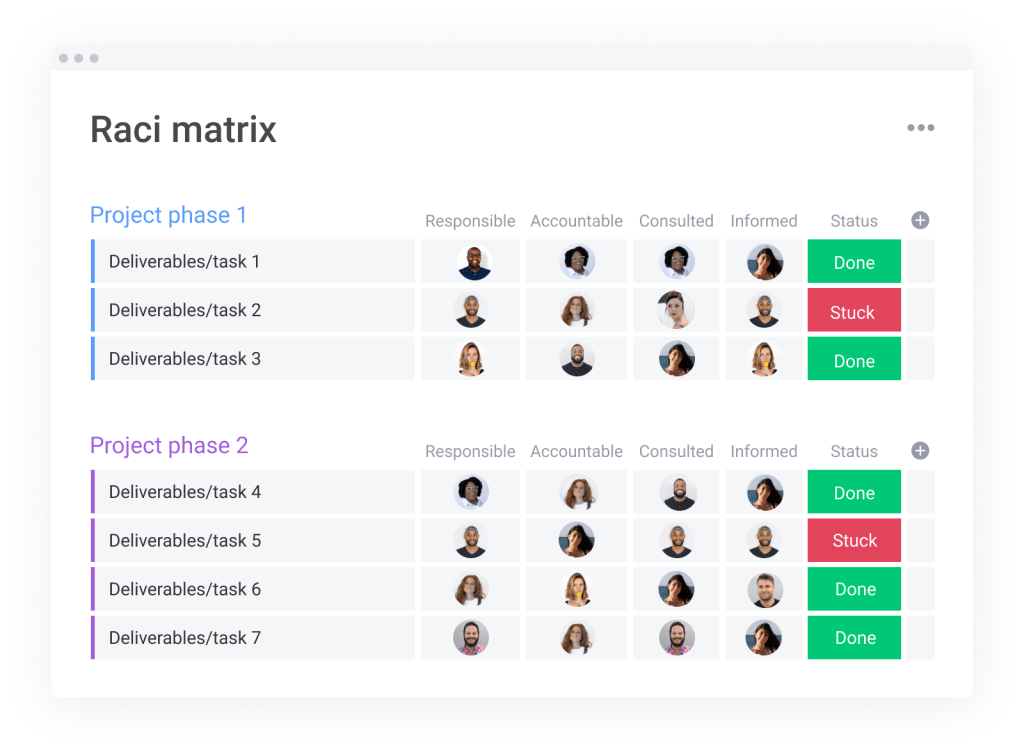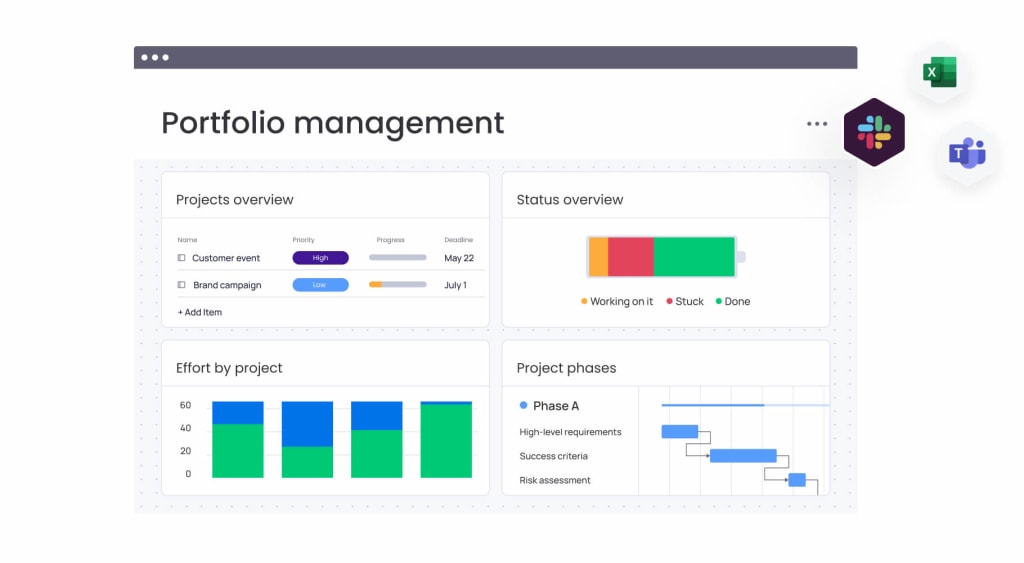Stakeholder analysis helps you better understand and manage everyone involved in a project — from the CFO approving your budget to the buyer making final purchases. By engaging with stakeholders early on and throughout a project, you can gain their support and increase the likelihood of project success.
In this guide, we’ll explain the benefits of stakeholder analysis and describe step-by-step instructions for conducting a stakeholder analysis. We’ll also show you how to analyze stakeholders with our stakeholder register template so you can streamline the process and achieve your project goals faster.
What is a stakeholder analysis?
Stakeholder analysis involves identifying and understanding the individuals, groups, or organizations that can impact or are impacted by a project. The process entails collecting and analyzing information about stakeholders, their needs, expectations, and levels of influence and proactively addressing any potential issues before a project commences.
What is the purpose of a stakeholder analysis?
Stakeholder analysis aims to outline the key stakeholders and their needs at the start of a project. It’s essential to clearly understand each stakeholder’s expectations, as they may conflict with each other or the project’s objectives.
The benefits of stakeholder analysis include:
- Ensuring stakeholder buy-in. By understanding the expectations and needs of stakeholders, managers can secure their support and involvement throughout the project.
- Gaining early alignment among all stakeholders on goals and plans. By bringing together key individuals and groups to discuss the project’s strategic objectives and plans, stakeholder analysis ensures everyone can contribute to its success.
- Addressing conflicts or issues early on. Through stakeholder analysis, project managers can proactively address potential conflicts or issues with key stakeholders and remove any resistance or obstacles to the project’s success.
These benefits highlight the strategic importance of stakeholder analysis in project management and organizational decision-making.
How to conduct stakeholder analysis step-by-step
Follow these four steps when performing a stakeholder analysis:
1. List
Start by identifying all the individuals, groups, or organizations that can impact or are impacted by your project. This includes internal and external stakeholders such as project managers, team members, senior management, clients, partners, investors, suppliers, and end users.
2. Analyze
Once you have listed your stakeholders, gather information about their needs, expectations, and potential impact on the project. This understanding will help you plan targeted communications and engagement strategies for each stakeholder group.
3. Prioritize
Assess the level of influence and interest of each stakeholder. You can use a stakeholder map to visually assess key stakeholders and determine the appropriate actions for each group.

4. Engage
Plan and implement communication and engagement strategies tailored to the needs and expectations of each stakeholder group. This may involve regular updates, feedback sessions, or other forms of interaction to ensure their support and involvement in the project.
Stakeholder analysis example
To put these steps into context, imagine you’re running a project to install a new offshore wind farm.
Stakeholder analysis will help identify the most critical stakeholders to engage with, plan for various risks and objections, and increase local support for any necessary changes. The process might look like this:
1. Stakeholder identification
For the offshore wind farm project, potential stakeholders might include:
- Local communities and residents
- Environmental groups
- Government bodies (local, regional, and national)
- Investors and partners
- Suppliers and contractors
- Regulatory bodies
2. Stakeholder analysis
After identifying the stakeholders, you might discover:
- Local communities raise concerns about the visual impact and noise.
- Environmental groups express interest in the project’s impact on marine life.
- Government bodies focus on compliance with regulations and the project’s contribution to renewable energy targets.
- Investors want to know the project’s financial viability and return on investment.
- Suppliers and contractors seek clarification on the bidding process and project timelines.
3. Stakeholder prioritization
Next, you can prioritize stakeholders based on their level of influence and interest in the project. You could use a stakeholder grid for this purpose, placing stakeholders in categories such as high influence/high interest (to be managed closely) and low influence/low interest (to be monitored).
Alternatively, you could use a RACI matrix template to help visually represent the various stakeholder roles and responsibilities of a project.

4. Stakeholder engagement
Finally, based on the analysis and prioritization, you can create a plan to effectively engage with each stakeholder group. This might include:
- Regular project updates and consultation meetings with local communities to address their concerns.
- Collaborating with environmental groups to minimize the project’s ecological footprint.
- Ensuring compliance with all government regulations and seeking government support for the project.
- Providing clear and transparent information to investors about the project’s progress and financial outlook.
- Engaging with suppliers and contractors through fair and transparent procurement processes.
This hypothetical example demonstrates how stakeholder analysis can help understand and address various stakeholders’ concerns and expectations, ultimately contributing to the project’s success by ensuring support and minimizing resistance.
How to analyze stakeholders with monday.com
Performing stakeholder analysis is much easier on monday.com with our intuitive stakeholder register template.

Instead of using a handwritten or spreadsheet list, you can identify project stakeholders, centralize their contact details, and boost your stakeholder engagement from one main board with features like:
- Smart columns: Classify each stakeholder with columns such as role, level of interest, level of influence, and more.
- Curated statuses: Use our pre-loaded statuses or add your own custom text and color.
- Progress tracking: Sort and filter your board in seconds to see stakeholders by type or project.
Aside from the main board, monday.com keeps you aligned with your stakeholders through:
- Dashboards: Communicate real-time data with stakeholders and get a high-level view of where projects stand for easy decision-making.

- Forms: Collect the information you need to efficiently share streamlined project requests and proposals with stakeholders.

- Files: Upload key files and assets for review and storage, then use a Tag Column to easily filter them according to stakeholder role, status, and more.

- Automations: Avoid unnecessary meetings or lengthy email chains with automatic notifications that notify stakeholders immediately when you complete initiatives or a project status changes.

Streamline your stakeholder analysis
Using powerful building blocks such as templates, automations, and dashboards, you can easily streamline your stakeholder analysis on monday.com.
That’s exactly what Canva did. Before using monday.com, its creative teams were drowning in a sea of updates and notifications as they used several tools to receive requests and loop in stakeholders on project progress.
After making the switch, Canva streamlined operations and reduced production time by:
- Using forms to create an automated database of creative requests.
- Optimizing production boards to increase transparency and decrease stakeholder questions.
- Building Slack integrations to automatically notify stakeholders when project statuses change.
In less than a year, the team removed 657 manual actions and tripled creative output to produce 60,000 ads.
With monday.com, you have everything you need to conduct your stakeholder analysis and stakeholder management in one place and keep everyone up-to-date. Together, you can collaborate on projects to reach your shared goals faster.
